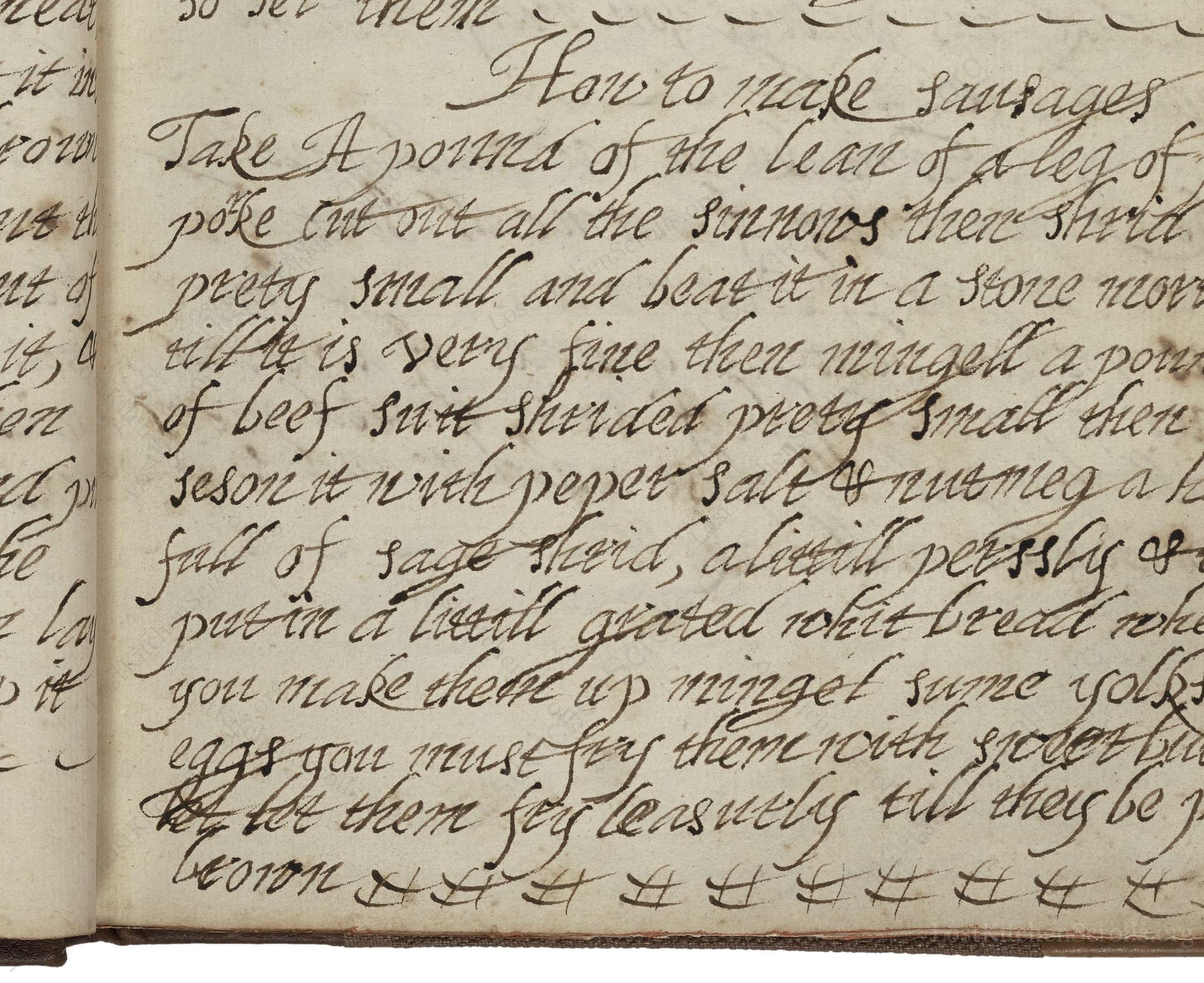How To Make Sausages
From the treasured pages of Cookbook of Constance Hall
Written by Constance Hall

How To Make Sausages
"Take A pound of the lean of a leg of porke poke cut out all the sinnows then shrid it pretty small and beat it in a stone morter till it is very fine then mingell a pound of beef suit shirded pretty small then seson it with peperse salt & nutmeg a hand full of sage shrid, a littlely persly & time put in a littlell grated white bread then you make them up in ringel some yolks of eggs you must fry them with sweet butterr & let them fry lensuly till they be pretty beorwn"
Note on the Original Text
This recipe is written in the loose narrative style common to the 17th century, without measured quantities except by reference to familiar weights (a pound) or handfuls. Spellings are phonetic and variable (e.g., 'sinnows' for sinews, 'shrid' for shredded, 'beorwn' for brown). Recipes relied on assumed domestic knowledge, so details like exact cooking times or temperatures are absent, with instructions such as 'fry lensuly' (meaning gently/slowly) reflecting a reliance on the cook's skill.

Title
Cookbook of Constance Hall (1672)
You can also click the book image above to peruse the original tome
Writer
Constance Hall
Era
1672
Publisher
Unknown
Background
A spirited foray into 17th-century kitchens, this collection by Constance Hall brims with the flavors, secrets, and delicacies of Restoration-era England—perfect for cooks keen to revive a dash of history in their modern menus.
Kindly made available by
Folger Shakespeare Library
This recipe comes from a 1672 manuscript attributed to Constance Hall, reflecting English household culinary practice in the late 17th century. At this time, sausage-making was typically part of seasonal butchering rituals and relied heavily on fresh herbs and locally butchered meats. Recipes were passed down within wealthy households, often by women compiling domestic manuscripts, and captured the tastes of an emerging gentry class—sage and nutmeg being an especially fashionable combination. The use of beef suet and fresh herbs also suggests a rustic mix of economy and flavour, typical of the period.

In the 17th century, this sausage would have been made using a heavy stone mortar and pestle for pounding the meat—a process requiring both strength and patience. A large kitchen knife was necessary for chopping meat and herbs finely. The mixture was shaped by hand into rings or links (casings, if available, or simply by hand-forming). Sausages were fried in a heavy copper or iron pan over a wood or coal fire, with the cook watching carefully to achieve a gentle, even browning.
Prep Time
30 mins
Cook Time
20 mins
Servings
6
We've done our best to adapt this historical recipe for modern kitchens, but some details may still need refinement. We warmly welcome feedback from fellow cooks and culinary historians — your insights support the entire community!
Ingredients
- 1 lb lean pork leg (no sinew)
- 1 lb beef suet (or substitute beef/pork fat)
- 2-3 egg yolks
- 1 oz fresh sage (finely chopped)
- 1 tablespoon fresh parsley (finely chopped)
- 1 teaspoon fresh thyme leaves
- 3/4 oz white breadcrumbs (freshly grated)
- 1 teaspoon salt
- 1 teaspoon freshly ground black pepper
- 1/4 teaspoon grated nutmeg
- Butter (for frying, approx. 1 oz)
Instructions
- To make historical sausages using modern imperial measures, start by taking 1 pound of lean pork leg, removing any sinew, and chopping it finely.
- Use a food processor or mortar and pestle to pound the pork until very fine.
- Next, mix in 1 pound of finely chopped beef suet (if unavailable, substitute with beef fat or a mix of butter and pork fat).
- Season generously with freshly ground black pepper, salt, and a pinch of grated nutmeg.
- Finely chop a handful (about 1 ounce) of fresh sage, along with a little parsley and thyme, and add to the meat.
- Mix in about 3/4 ounce of fresh white breadcrumbs.
- Shape the mixture into sausage rings or links.
- To bind, use egg yolks (2-3), then fry the sausages gently in butter over medium-low heat until they are nicely browned and cooked through.
Estimated Calories
470 per serving
Cooking Estimates
Preparing these historical sausages takes about 30 minutes, including chopping meat and herbs, mixing, and shaping the sausages. Cooking them gently in butter takes another 20 minutes. Each sausage serving contains about 470 calories. This recipe makes 6 servings.
As noted above, we have made our best effort to translate and adapt this historical recipe for modern kitchens, taking into account ingredients nowadays, cooking techniques, measurements, and so on. However, historical recipes often contain assumptions that require interpretation.
We'd love for anyone to help improve these adaptations. Community contributions are highly welcome. If you have suggestions, corrections, or cooking tips based on your experience with this recipe, please share them below.
Join the Discussion
Rate This Recipe

Den Bockfisch In Einer Fleisch Suppen Zu Kochen
This recipe hails from a German manuscript cookbook compiled in 1696, a time whe...

Die Grieß Nudlen Zumachen
This recipe comes from a rather mysterious manuscript cookbook, penned anonymous...

Ein Boudain
This recipe comes from an anonymous German-language manuscript cookbook from 169...

Ein Gesaltzen Citroni
This recipe, dating from 1696, comes from an extensive anonymous German cookbook...
Browse our complete collection of time-honored recipes



